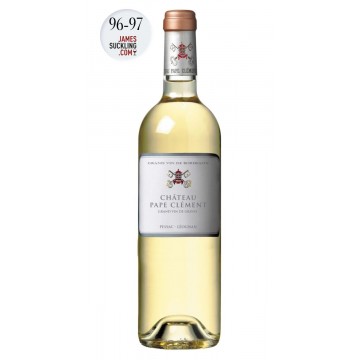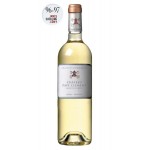2023 Chateau Pape Clement Blanc [EP 2023]
-
S$15799
ETA: 2026

Vintage: 2023
Region: Pessac Leognan
Country: France
Winemaker Notes
2023 was a challenging vintage, where tenacity, adaptability, and patience were once again important factors in crafting a great vintage at Château Pape Clément!
Our cool, clayey terroir allowed us to protect our white grapes from the very warm temperatures at the end of the ripening process, preserving the subtle aromas and the tension of the Sauvignon, while enabling the Semillon to fully express its unrivalled silky texture.
Blend: 60% Sauvignon Blanc, 35% Semillon, 4% Sauvignon Gris, 1% Muscadelle
About Winery
Origins
Chateau Pape Clément owes its name to its most illustrious owner. A man of the cloth born in 1264, Bertrand de Goth became Bishop of Comminges, in the Pyrenees Mountains, at the age of 31; he later became Archbishop of Bordeaux in 1299.
He then received as a gift the property in Pessac, the Vineyard de La Mothe. Taken by a passion for the vine, he continually took part personally in equipping, organizing and managing the domain in accordance with the most modern and rational practices. Nevertheless, on 5 June 1305 the cardinals met in a conclave in Pérouse and appointed him to succeed Pope Benedict XI, who had passed away prematurely after only eleven months of reign. Bertrand de Goth took the name of Clement V.
Supported by Philip IV, it was he who decided in 1309 to move the papal court to Avignon, thus breaking with Rome and its battles of influence. During this same period, the weight of his responsibilities led him to relinquish his property, giving it to the Archbishop of Bordeaux. Henceforward, the vineyard was to be known to posterity under the name of this enlightened pope.
The early period
Management under the clergy brings modernity The grateful Church perpetuated Pope Clement's work. Each archbishop in turn turned to modernity and technical progress, to the point of the wine estate becoming a model vineyard. In addition to especially early harvests, which remain one of its special characteristics, Chateau Pape Clément is without a doubt the first vineyard in France to align vine stock to facilitate labour.
After the Revolution
At the end of the 18th century, the Archbishop of Bordeaux was dispossessed of his property. The papal vineyard became part of the public domain.
The 20th century
8 June 1937 was a dark day in the vineyard's history, when a violent hailstorm destroyed virtually the entirety of the estate. Two years later, Paul Montagne bought it and gradually brought it back to life. Thanks to his efforts, the vineyard returned to its former rank and stood up to the surge in urbanization. His descendents, Léo Montagne and Bernard Magrez, perpetuate this secular tradition so that Chateau Pape Clément wines continue to delight the wine-lovers of today and tomorrow.
Price:
Per unit $157.99; Buy 3 or More $473.99; Buy 6 or More $947.99
Available Options
Winemaker Notes
2023 was a challenging vintage, where tenacity, adaptability, and patience were once again important factors in crafting a great vintage at Château Pape Clément!
Our cool, clayey terroir allowed us to protect our white grapes from the very warm temperatures at the end of the ripening process, preserving the subtle aromas and the tension of the Sauvignon, while enabling the Semillon to fully express its unrivalled silky texture.
Blend: 60% Sauvignon Blanc, 35% Semillon, 4% Sauvignon Gris, 1% Muscadelle
About Winery
Origins
Chateau Pape Clément owes its name to its most illustrious owner. A man of the cloth born in 1264, Bertrand de Goth became Bishop of Comminges, in the Pyrenees Mountains, at the age of 31; he later became Archbishop of Bordeaux in 1299.
He then received as a gift the property in Pessac, the Vineyard de La Mothe. Taken by a passion for the vine, he continually took part personally in equipping, organizing and managing the domain in accordance with the most modern and rational practices. Nevertheless, on 5 June 1305 the cardinals met in a conclave in Pérouse and appointed him to succeed Pope Benedict XI, who had passed away prematurely after only eleven months of reign. Bertrand de Goth took the name of Clement V.
Supported by Philip IV, it was he who decided in 1309 to move the papal court to Avignon, thus breaking with Rome and its battles of influence. During this same period, the weight of his responsibilities led him to relinquish his property, giving it to the Archbishop of Bordeaux. Henceforward, the vineyard was to be known to posterity under the name of this enlightened pope.
The early period
Management under the clergy brings modernity The grateful Church perpetuated Pope Clement's work. Each archbishop in turn turned to modernity and technical progress, to the point of the wine estate becoming a model vineyard. In addition to especially early harvests, which remain one of its special characteristics, Chateau Pape Clément is without a doubt the first vineyard in France to align vine stock to facilitate labour.
After the Revolution
At the end of the 18th century, the Archbishop of Bordeaux was dispossessed of his property. The papal vineyard became part of the public domain.
The 20th century
8 June 1937 was a dark day in the vineyard's history, when a violent hailstorm destroyed virtually the entirety of the estate. Two years later, Paul Montagne bought it and gradually brought it back to life. Thanks to his efforts, the vineyard returned to its former rank and stood up to the surge in urbanization. His descendents, Léo Montagne and Bernard Magrez, perpetuate this secular tradition so that Chateau Pape Clément wines continue to delight the wine-lovers of today and tomorrow.
James Suckling 96-97
"Dense and tight with a solid core of sliced Meyer lemon, lime and green apple. It’s full and very compact with a phenolic texture that runs the length of the wine. Slightly chewy, yet, it’s long and persistent with a mineral and bitter citrus undertone at the end."
Vinous 93-95
"The 2023 Pape Clément Blanc is another strong vintage for a wine that has been in transition for a few years now. There's still plenty of textural richness in the Blanc, but less of the tropical character and flamboyance of some past years. Orange peel, mint, dried herbs, chamomile and crushed flowers open gracefully. All the elements are so well balanced. Tasted three times." –Antonio Galloni



![2023 Chateau Haut Brion [EP 2023] 2023 Chateau Haut Brion [EP 2023]](https://winehours.com/image/cache/catalog/Wine%20Shop/BEP%202023/2023-CHATEAU-HAUT-BRION-350x450.jpg)
![2023 Chateau Angelus [EP2023] 2023 Chateau Angelus [EP2023]](https://winehours.com/image/cache/catalog/Wine%20Shop/BEP%202023/2023-CHATEAU-ANGELUS-350x450.jpg)
![2023 Chateau Gazin [EP2023] 2023 Chateau Gazin [EP2023]](https://winehours.com/image/cache/catalog/Wine%20Shop/BEP%202023/2023-chateau-gazin-350x450.jpg)
![2023 Domaine de Chevalier Blanc [EP2023] 2023 Domaine de Chevalier Blanc [EP2023]](https://winehours.com/image/cache/catalog/Wine%20Shop/BEP%202023/2023-domaine-de-chevalier-350x450.jpg)


